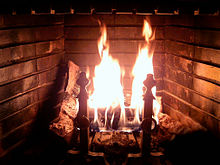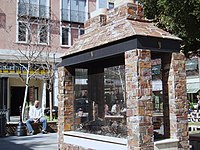Fireplace
From Wikipedia, the free encyclopedia
| This article needs additional citations for verification. Please help improve this article by adding citations to reliable sources. Unsourced material may be challenged and removed. (May 2008) |
Contents[hide] |
[edit] Types of fireplaces
- Masonry fireplaces made from brick or stone.
- Manufactured fireplaces with sheet metal fire boxes.
Chimney and flue types:
- Masonry (brick or stone fireplaces and chimneys) with or without tile-lined flue.
- Reinforced concrete chimneys. Fundamental design flaws bankrupted the US manufacturers and made the design obsolete. These chimneys often show vertical cracks on the exterior.
- Metal-lined flue: Double or triple walled metal pipe running up inside a new or existing wood-framed or masonry chase.
[edit] History
Ancient fire pits were sometimes built in the ground, within caves, or in the center of a hut or dwelling. Evidence of prehistoric, man-made fires exists on all five continents. Chimneys, invented much later, partially fixed this problem, venting smoke outside.In 1678 Prince Rupert, nephew of Charles I, raised the grate of the fireplace, improving the airflow and venting system. The 18th century saw two important developments in the history of fireplaces. Ben Franklin developed a convection chamber for the fireplace that greatly improved the efficiency of fireplaces and wood stoves. He also improved the airflow by pulling air from a basement and venting out a longer area at the top. In the later 18th century, Count Rumford designed a fireplace with a tall, shallow firebox that was better at drawing the smoke up and out of the building. The shallow design also improved greatly the amount of radiant heat projected into the room. Rumford's design is the foundation for modern fireplaces.
[edit] Evolution of fireplace design
Over time the design of fireplaces has changed from one of necessity to one of visual interest. Early ones were more fire pits than modern fireplaces. They were used for warmth on cold days and nights, as well as for cooking. They also served as a gathering place within the home. These fire pits were usually centered within a room, allowing more people to gather around it.Many flaws were found in early fireplace designs. Along with the industrial revolution came large scale housing developments, obviating a standardization of fireplaces. The most renowned fireplace designers of this time were the Adam Brothers. They perfected a style of fireplace design that was used for generations. It was smaller, more brightly lit, with an emphasis on the quality of the materials used in their construction, instead of their size.
By the 1800’s most new fireplaces consisted of two parts, the surround and the insert. The surround is the mantle and sides and was usually made of wood, marble and granite. The insert is the part of the fireplace where the fire is burned. This part was constructed of cast iron and sometimes decorated with tiles. During the Victorian era, fireplaces were thought to add a cozy, relaxing ambiance to homes.[1]
[edit] Heating efficiency
The heating effect of a fireplace is largely due to radiative heating, by which objects surrounding the fireplace are heated up, and some of this heat is transferred to the air. It is a common misconception that a fireplace leads to energy savings by reducing the heating load on a home. In fact, a fireplace moves large amounts of air out of the home which must be replaced by outside air.[2] The outside air, presumably at a lower temperature, must be heated by the home's heating, ventilation, and air conditioning system. Some fireplace units incorporate a blower which transfers more of the fireplace's heat to the air via convection, resulting in a more evenly heated space and a lower heating load.The most effective fireplaces in terms of heating efficiency are modern, wood-burning masonry fireplaces. Modern masonry fireplaces are often equipped with a large fire window, enabling an efficient heating process in two phases. During the first phase the initial heat is provided through a large glass window while the fire is burning. During this time the structure, built of refractory bricks, absorbs the heat. This heat is then evenly radiated for many hours during the second phase. Masonry fireplaces without a glass fire window only provide heat radiated from its surface. Depending on outside temperatures 1 to 2 daily firings are sufficient to ensure a constant room temperature.


